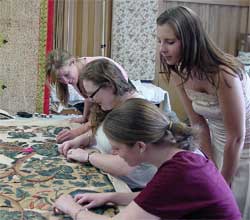 KINGSTON, R.I. – September 25, 2009 – The Beatles and Mike Myers’ Dr. Evil wore Nehru jackets. Teenagers across the country wear madras shorts, and sari fabric has influenced all kinds of light and breezy fashions.
KINGSTON, R.I. – September 25, 2009 – The Beatles and Mike Myers’ Dr. Evil wore Nehru jackets. Teenagers across the country wear madras shorts, and sari fabric has influenced all kinds of light and breezy fashions.
Find out more about India’s influence on fashion and design when the University of Rhode Island’s Department of Textiles, Fashion Merchandising and Design opens an exhibit, “Elephants, Paisleys, and Plaids: Indian Influence on Western Textile Design,” with a reception Monday, Sept. 28 at 4:30 p.m. in the Textile Gallery in Quinn Hall, 55 Lower College Road, Kingston.
The exhibit, a part of the URI Honors Colloquium, “Demystifying India,” remains open until March, Monday through Friday, 8:30 a.m. to 4:30 p.m.
In addition, Textiles Department Chair Linda Welters and Professor Margaret Ordoñez will discuss the topic Monday, Oct. 5 at 2 p.m. at the Multicultural Center, 74 Lower College Road, as part of URI Diversity Week.
The exhibit and discussion are all free and open to the public.
The exhibit will showcase a wide range of Indian clothing and textiles from URI’s Historic Textile and Costume Collection. For each Indian textile or fashion, there will be a corresponding western piece that was inspired by India.
“India has had the greatest influence on western design and textiles than any other country,” said Margaret Ordonez, professor of textiles, fashion merchandising and design. “That influence on western textile design began as early as the 1600s.”
Kira Munroe of Taunton, Mass., a graduate student in the department who is the curator of the exhibit, went to India in 2006.
“It was kind of overwhelming, with the trash, the congestion and the animals. But I fell in love with the country and the culture,” Munroe said.
“The connection between India and the West is so strong,” she said. “The textiles and fashions we have here have their roots in India.”
Just days before the show opened, fellow graduate students Michelle Harbeson of Baltimore, Md., and Annie-Beth Ellington of London, Ky. and undergraduate Danielle Desmarais of Atkinson, N.H. sewed a new backing to a 7-foot by 7-foot early 18th-century English embroidered textile based on the Indian tree of life pattern. It will be a key piece in the show.
The sari, the draped garment worn by Indian women, will be a prominent part of the exhibit. Tia Lahiri, the mother of world-renowned author Jhumpa Lahiri, who is speaking at the colloquium on Nov. 10, provided advice on the exhibit, and draped the exhibition sari.
“Tia has been our advisor,” Ordoñez said. “She knows so much about where the items were made.”
The Nehru jacket, popularized by Jawaharlal Nehru, the prime minister of India from 1947 to 1964, has been a fashion statement for years and will be another part of the exhibit.
Pictured above
University of Rhode Island Textiles, Fashion Merchandising and Design students prepare an early 18th-century English crewel embroidery that was inspired by printed cottons from India. Seated from front to back are graduate students Annie-Beth Ellington and Michelle Haberson and undergraduate Danielle Desmarais. Standing is graduate student Kira Munroe, the curator of the exhibit. URI Photo by Margaret Ordoñez.

